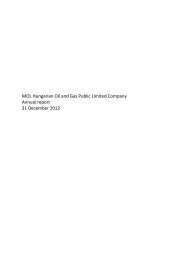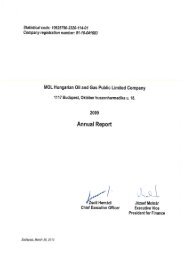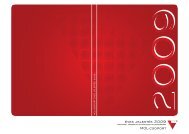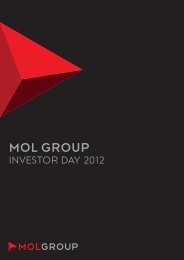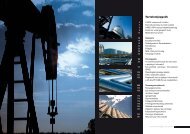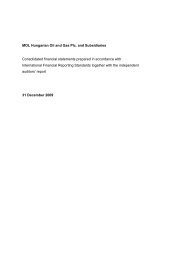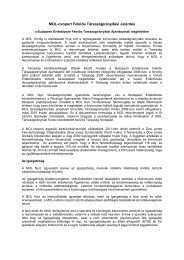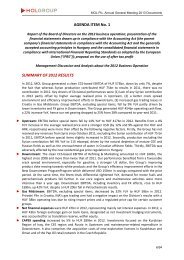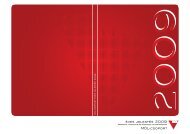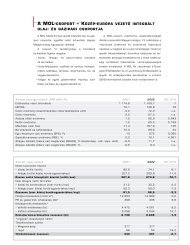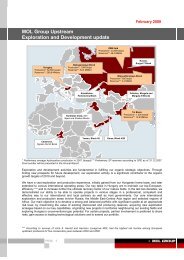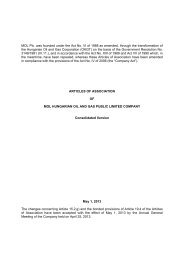MOL GROUP Annual Report
MOL GROUP Annual Report
MOL GROUP Annual Report
- No tags were found...
Create successful ePaper yourself
Turn your PDF publications into a flip-book with our unique Google optimized e-Paper software.
Higher personal expenses due to fullyear contribution of INA<strong>MOL</strong> remained one of the mostprofitable Upstream players.operations (HUF 8.6 bn) and the higher mining royalty (HUF 31.4 bn). In additionHUF 30.4 bn was paid in Q3 2010 for the additional mining royalty based on thedecision of the EU Commission for which provision was recognized in Q2 2010.On October 18, 2010 the Hungarian Parliament approved a temporary crisis taximposed on the energy sector until 2012. The crisis tax recorded in the amountof HUF 25.8 bn reflects the payable amount by <strong>MOL</strong> Group with respect to theyear 2010. The consolidation of INA also increased other operating expenses byHUF 78.4 bn (HUF 31.3 bn in H2 2009), from which HUF 10.3 bn is attributable tothe net foreign exchange loss on INA’s trade receivables and payables. On grouplevel, in the comparative period, a net foreign exchange gain of HUF 6.5 bn wasrecognised on such items.Personnel expenses increased by 35% to HUF 272.0 bn compared to prior year,mainly due to INA’s 2010 contribution of HUF 118.5 bn (HUF 53.1 bn in H2 2009),including the redundancy provision which was recognized in Q3 2010 at INA (HUF15.5 bn, the majority of which was paid in Q4 2010).Of the production costs incurred in 2010, excluding INA’s contribution incurred(HUF 16.4 bn and HUF 50.0 bn in 2010 and 2009, respectively), HUF 34.5 bn isattributable to the increase in the level of finished goods and work in progresscompared to the increase of HUF 5.9 bn in 2009.Exploration and Production OverviewIn 2010 <strong>MOL</strong> made significant steps towards an optimized, efficiently operatedupstream portfolio and further improved its solid basis for future growth.Production increased to 143.5 mboepd on the top of the record-high basis of 2009mainly as a result of recent years’ major developments turning into production inSyria, Pakistan and the Adriatic offshore area while keeping onshore productionat a stable level with enhanced and intensified oil and gas recovery technologies.Remarkable exploration successes in the Kurdistan Region of Iraq and Pakistanproved our capabilities and will support the sustainability of an increasedproduction level on the long term.While the existing balanced exploration portfolio with low risk, medium-sizedCEE prospects recently has been extended with Romanian exploration blocks, ourprosperous international perspectives in the Kurdistan Region of Iraq, Kazakhstanand Pakistan provide a solid base to further increase of our reserve base andfuture production. Our enlarged Upstream portfolio has sizeable production in 7countries and exploration potential in 13 countries.During 2010, our focus in the CEE region remained on the development projectswith short cash recovery periods and on further increasing operating efficiency byimplementing a range of cost austerity and reduction measures.In Syria the completion of Jihar oil and gas station in late 2009 enabled significantproduction increase in 2010. In Pakistan our production continued to expand,further increasing our profitability and stake in the local gas market. In Russia,field development in operated projects continued to compensate the naturaldecline of <strong>MOL</strong>’s largest field in Russia, the ZMB project.In 2010, we made further steps to maximize the value of our existing resourcebase through the use of enhanced and improved recovery techniques on ourexisting producing fields, and through establishing new projects in territoriesneighbouring our legacy assets, via strict cost control and efficient operation.– Highly competitive production unit cost of 6.6 USD/boe on Group level.Our upstream portfolio secures astrong basis for further productionincrease in forthcoming years as wellIncreasing profit share within Groupdue to higher INA contribution andstrong performance of other parts ofthe Division as wellHigher daily production level due toincreased INA contribution– Intensive field development activities were continued focusing on fieldswith short cash recovery periods.– Our widely known strong exploration track record continued further,as we claimed 14 discoveries out of a total 20 (out of which 7 belong toINA) exploration wells tested in 7 countries. New discoveries have addedapproximately 4.1 MMboe to our SPE 2P reserve base in Hungary.International discoveries are expected to increase our reserve base inthe following years after detailed assessment.– Established new partnerships in Hungary and in Romania.The main objective for the forthcoming years will be to maximise the value ofour existing portfolio. The focus will be on completing high return/early cashgenerative appraisal and development projects in Syria, CEE and Russia toincrease production levels, contributing significantly to Group-level EBITDA,growth. At the same time, we intend to extend <strong>MOL</strong>’s outstanding efficiency tothe whole Upstream portfolio. Remarkable exploration successes were achievedin the Kurdistan Region of Iraq and Pakistan in 2010. These successes along withincreasing exploration activity in the future should support our long term growth.In 2010 E&P segment’s operating profit, excluding special items was HUF 258.6bn, which is by HUF 113.8 bn or by 79% higher compared to the previous yearmainly due to higher contribution of the international activities. Realised averagehydrocarbon prices increased by 16% in USD-terms in 2010 (crude oil andcondensate prices were higher by 24% in line with Brent changes). The Croatiangas trading business was still in loss, albeit reduced from the previous year.Excluding special items and INA contribution, operating profit was HUF 130.7bn, which is by HUF 22.0 bn or by 20% higher than in 2009 mainly driven bythe higher average hydrocarbon price in line with strengthening oil prices andthe weakener HUF against the USD that was partially compensated by slightlylower production. Production volumes in general (excluding INA contribution)declined by 1% due to natural depletion of the Hungarian and Russian fields.Realised average hydrocarbon prices increased by 12% in USD-terms in 2010,crude oil and condensate prices were higher by 26% in line with Brent changes,while gas prices decreased only by 3% due to increase in ratio of Pakistani gasproduction (Hungarian gas prices increased only by 3% as gas price is based uponprevious nine-month average of oil products prices). These changes were partlycompensated by the weakened HUF by 3% to the USD.The impact of prices and volumes were reflected in revenues and expenditures.– Revenues, excluding INA’s contribution, increased by HUF 42.4 bn or13% to HUF 375.9 bn in 2010 compared to 2009.– Royalties on Hungarian production increased by HUF 20.1 bn year-onyearto HUF 89.3 bn. The mining royalty and export duty paid in Russiaincreased by HUF 14.9 bn to HUF 44.5 bn.The combined effect of increasing tax payments as a consequence of higher crudeoil and gas prices and lower volumes, excluding INA’s contribution, operatingcosts excluding special items increased by HUF 20.4 bn or 9% to HUF 245.2 bn.The total hydrocarbon production was 143.5 mboepd in 2010. Crude oilproduction increased by 13%, condensate production by 32%, gas productionby 49%. Excluding INA contribution, total hydrocarbon production averaged ataround 78.0 mboepd in 2010, representing a 1% decrease year-on-year. Totalcrude oil production (excluding INA’s contribution of 16.3 mboepd) declined by5%, condensate production (excluding INA’s contribution of 7.2 mboepd) fell by 5% too, and gas production (excluding INA’s contribution of 42.0 mboepd) was 3%higher than the level reached in 2009.Management Discussionand Analysis58 <strong>MOL</strong> Group ANnual <strong>Report</strong> 2010 59



